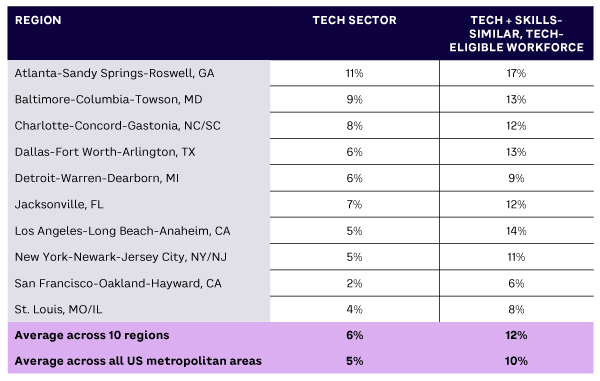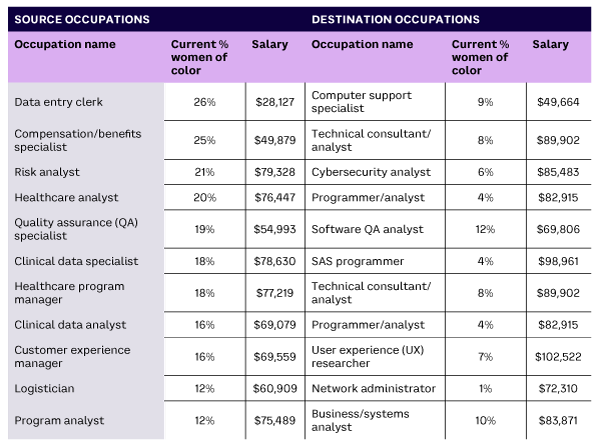NPower, a skills-training and advocacy organization, and Lightcast, a labor market analytics firm, are working to apply the Equation for Equality to the tech sector. This sector is a good example of the expanded talent pool revealed by the Equation for Equality. Rapid digitalization across a broad range of non-tech jobs and the importance within the tech sector of skill sets related to business, operations, user experience, and customer support coincide to produce a much larger talent pool for traditional tech jobs than is typically considered.
Black, Latina, and American Indian women hold 5% of tech jobs. But when we apply the Equation for Equality to these occupations, we see that these women hold 10% of skills-similar jobs — those that use the knowledge, skills, and abilities commonly sought in the tech sector.
What’s more, this tech-eligible workforce is more than five times larger than the tech workforce. There are close to 5 million workers in tech occupations in the US but more than 25 million workers in jobs that share a high degree of skills content with jobs in the tech sector.
If employers tapped into this skills-similar, tech-eligible workforce, there would be nearly 250,000 more women of color in tech jobs today, double the number currently in tech.
Applying Equation for Equality at the Company Level
The Equation for Equality can also be used at the company level. NPower and Lightcast applied the equation across tech jobs in 10 large US metropolitan regions. With this data, employers can see the current demographic characteristics of the tech sector in their market as well as the demographic characteristics of the skills-similar, tech-eligible workforce that they could access. Putting these two candidate pools together reveals the demographic characteristics of the full tech-talent pool.
Firms can use these figures to set goals and benchmarks for the diversity of their own tech workforce. During the hiring process, companies can set top-of-the-funnel and bottom-of-the-funnel goals and benchmarks. The top of the funnel refers to the candidate pool at the first stage of the hiring process. The bottom of the funnel refers to the individuals who are ultimately selected. If companies benchmark the top of the funnel against the full talent pool and the bottom of the funnel against the current demographics in the tech workforce, they can be sure their hiring will promote equity within the sector over the long term. Table 1 shows how this looks in the 10 metropolitan regions studied by NPower and Lightcast.

Companies can also refer to job-level data on the demographic characteristics of tech occupations and skills-similar, tech-eligible occupations. Table 2 shows a handful of examples. With job-level data, tech executives, HR professionals, and hiring managers can be intentional about recruitment and outreach to workers in skills-similar, tech-eligible jobs where women of color are better represented.

Finally, the equation can be applied at a company level to develop internal ladders for advancement. It can be difficult for C-suite executives to understand the internal pathways that exist within their workforce, but they often know which departments and teams are facing staffing challenges. By identifying the occupations facing staffing challenges, executives and HR leaders can use the equation to identify skills-similar feeder roles that can source talent for those occupations.
Many companies, especially large ones, find that they already employ workers in those feeder occupations. They can then devote resources in a targeted way to upskill workers in feeder roles so they can transition into those in-demand roles. This process develops internal career ladders that benefit the incumbent workforce, supports retention, and meets the organizational needs of the company.
[For more from the author on this topic, see: “The Equation for Equality.”]



